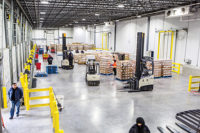When a prominent food distribution company purchased a piece of property just outside of Austin, Texas, for a new branch facility, the representatives wanted to do more with the building than just store and distribute product.
They were looking to use the facility to increase the company’s presence and marketability and set themselves apart from competitors. The building was to have a modern contextual look, a high-end kitchen for product introductions and high-tech, state-of-the-art training and presentation rooms. But, the largest difference was that it had to be LEED Silver.
At the time, LEED was relatively new, and its application to cold storage had been very limited. It was a rating system designed mostly for traditional building typology like offices, retail establishments and schools, not refrigerated cold storage or processing facilities.
The company felt that a LEED-certified building would show the public that it maintains a long-term commitment to sustainability.
Here’s how food processors can achieve LEED certification:
Infiltrate sustainability from the top down. In getting a building certified, the first thing that must be accomplished is committing to the idea of sustainability in almost every aspect of the business. Establish the environment of sustainability at the leadership level and be willing and open to modify the way things were done in the past to improve sustainability going forward. This transition must come from the top down. Buildings can be constructed to be efficient, but they need to operate correctly and with the right mindset to truly take advantage of what LEED has to offer.
Create a game plan. Creating a game plan for certification generally begins with hiring a LEED consultant, typically an engineer. These experts are familiar with the LEED credits, and hopefully through understanding the business will arrive at a credit road map early in the process. They will start out by creating a checklist of possible credits out of the 100 that the building will typically qualify for or are easily obtainable.
LEED is set up on a point system based on credits achieved. Some credits are worth more than others based on the potential environmental impacts and the human benefits of each. There are 100 available base points divided among five different categories—sustainable sites, water efficiency, energy and atmosphere, materials and resources and indoor environmental quality. In addition, there are 10 prerequisites for qualifications, and achieving these do not count as credits.
Most of the “low hanging fruit” credits do not have cost implications, but rather include a change in the status quo, for example, low water flow fixtures, preferred parking for carpools and high-efficiency vehicles and drought-resistant landscaping, to name a few. Many are inherent in the engineering of the building, such as stormwater management credits that match most government guidelines. Others are credits that, through good design of cold storage facilities, are naturals like white roofing with a highlight reflectance, high-efficiency refrigeration systems and the use of LED lighting.
Commissioning the building is a prerequisite and requires bringing in an independent third-party engineering group, hired directly by the owner, to review all of the systems and verify that they were installed correctly and are operating as designed. Many hours are spent on the roof, in electrical rooms and up in ceiling plenums confirming that electrical and mechanical systems are installed correctly. A commissioning group that specializes in refrigeration design must be hired, very often as a third-party consultant, because of the specialized nature of the industry. These commissioning studies can be expensive, but prove to be money savers by verifying that the mechanical systems, lighting and refrigeration systems are installed and running at optimum design levels.
Understand the alternatives. The LEED guidelines are not tailored for refrigerated buildings and as such, there are some pitfalls that must be navigated, otherwise certification is not possible. None is more imposing than the prerequisite that requires all occupied spaces be ventilated. This is really not possible in a freezer or cooler and requires variances to be granted or work-arounds to be provided. The U.S. Green Building Council, the Washington, D.C.-based organization that oversees LEED certification, is currently looking into alternatives to meet this requirement, but none have been formally adopted. This means each certification requires a different tack. Certification could take 12 months following building completion. Once certified, the building should be celebrated and shown off with building tours and marketing materials to maximize the return on the investment of certification, as well promote the idea of sustainability.
Achieving LEED certification for a refrigerated building is no easy task, but should be met with satisfaction that few have done it.







